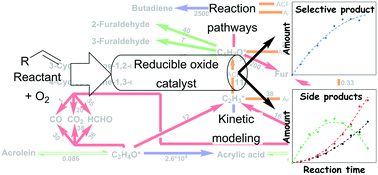Pathways, mechanisms, and kinetics: a strategy to examine byproduct selectivity in partial oxidation catalytic transformations on reducible oxides
Abstract
Oxidative transformations of organic molecules over reducible oxides provide essential routes for synthesis of high-value unsaturated or oxygen-containing organic compounds that serve as feedstock for synthesis of plastics and resins. Inherent in these transformations are thermodynamic and kinetic challenges associated with unselective and over-oxidation pathways. This review highlights experimental and data analysis techniques effective in elucidating sequential and parallel reaction pathways and mechanisms pervasive in catalytic partial oxidation over reducible oxides, (i) application of Wojciechowski's criteria to first-rank delplots, (ii) product co-feed experiments, (iii) isotopic labeling co-feed experiments, and (iv) probe molecule co-feed experiments. We illustrate that byproduct generation routes during partial oxidation of organic molecules over oxide catalysts exhibit commonalities in pathways that (i) preserve reactant C–C backbone structure, (ii) break C–C bonds, and (iii) form C–C bonds. Further, we show that kinetic modeling invoking either pseudo-first order rate expressions or reactions involving proposed surface intermediates enables quantitative description of consumption and production of byproduct species during catalytic partial oxidation reactions over reducible oxides.



 Please wait while we load your content...
Please wait while we load your content...